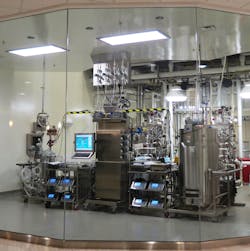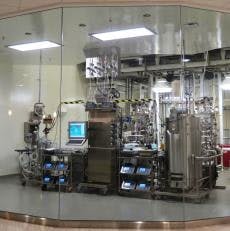In March 2011, Boehringer Ingelheim (BI) acquired an existing biotech manufacturing facility in Fremont, Ca. The decision to purchase the site was driven by three strategic objectives: to secure process development and production capacity for BI’s own range of biomolecules, to extend its global biotech contract manufacturing business, and to give BI a significant presence in the San Francisco Bay area, the largest biotechnology hub in the world.
At the time of acquisition, achieving those objectives looked like a daunting challenge. The site was producing a single commercial product, but BI needed the capability to make dozens of different molecules and to meet the needs of every stage of the development process from toxicology studies and the early clinical phase onward. If the facility were to enter the highly competitive contract manufacturing space, it would also need to dramatically increase its productivity and drive out cost. Quality needed to be on a very high level, both to satisfy regulators and to ensure that products were produced right first time even in a multi product set-up.
Site Vision
Using the strategic objectives as a starting point, and benchmarking Fremont against the best in the world, the site leadership team developed an ambitious vision for the facility. They started with targets for just five key performance indicators: productivity, on time delivery, right first time, ramp-up to multiproduct capability and a measure of staff mindsets. If the metrics were straightforward, however, the targets certainly were not.
For the leadership team, the transformation effort wasn’t just about meeting business objectives. The team wanted Fremont to become a shining star in the BI portfolio and the targets reflected that aim, including a threefold improvement in productivity, for example, and a 50% reduction in production deviations. The time frame was challenging, too: BI aimed to hit its targets within 18 months, while simultaneously making the changes needed to integrate the site into the systems and processes of the wider BI organization, as well as phasing out all infrastructure provided by the previous owner.
To achieve what BI had to do in the time available, the site leadership team designed the transformation effort in two phases. The first phase would deliver a rapid and significant improvement in both performance and staff mindsets, by making the most important, but sometimes painful, changes to the way the plant was operated and managed. The second phase would be about sustaining continuous improvements over the long term, and building world-leading capabilities at the site.
Critically, companies in the BI network assigned some of their most important biotech development and manufacturing projects to the site, and the site was also successful in quickly acquiring external contract development and manufacturing deals. The steep learning curve in operational execution and positive client feedback from these projects helped the site to gain confidence in its vision and ambitious targets.
Fast, Phased Change
For the initial phase of the transformation, the site established a steering committee to drive the change process. They knew that whatever changes were made at Fremont would need to be aligned with the wider BI organization, so that committee included representatives from the Global Operations, Quality and Process Sciences functions. The change effort began with a detailed diagnostic of the site. Working with a group of external advisors and biotech experts from within BI, the leadership team spent two weeks examining every aspect of the plant’s operations in order to find opportunities to eliminate waste and improve performance. The diagnostic team’s deep understanding of the unique challenges of biotech production helped them produce hundreds of improvement ideas in that time, with many suggestions also coming from their own staff.
Operating Improvements
About 200 of the ideas identified in the diagnostic process were “quick wins,” changes that cost little to implement, but could deliver substantial improvements on the ground. For example, BI replaced complex pipe jumpers comprising more than 17 components with a much simpler, three-component design. The new design meant reconfiguring connections, which went from a three-hour, two-person job, to a task that took a single operator less than half an hour. Similarly, the introduction of automated small parts washers meant that instead of requiring four people to manually clean components between batches, operationally the facility needed only one.
Making these changes quickly didn’t just give them immediate performance improvements, it also sent a powerful signal to everyone in the plant that BI was serious about the change process, and that the organization was ready to listen to their ideas and invest to put them into action.
After ‘wave zero’ of rapid improvements, BI started implementing the hundreds of detailed changes that would take the plant to where the company needed it to be. Those changes took place in three subsequent waves of about two months each. Each of these waves was designed to be broader in scope and the number of participating staff than the last. The team started by looking for improvement opportunities within individual functions, before moving on to examine cross-functional interactions, and finally to improvements in the way the plant interacted with its customers and the global BI organization.
The changes made during these phases were profound. A key focus, for example, was in reducing the cycle time to deliver a complete batch of product. By adopting a more aggressive approach to batch scheduling, improving the training of production staff, reducing unnecessary waiting time between steps and by implementing some key technical changes, like the introduction of faster in-process sampling technologies, BI found opportunities to reduce overall cycle time in downstream processing from 23 days to less than a week.
Performance Management
In any effort to transform the performance of a site, technical changes, whether to equipment or processes, are only one part of the story. The facility could only perform to its full potential if BI’s people were enabled and incentivized to perform to their full potential. Recognizing this, BI designed and implemented a completely new performance management system for the Fremont facility.
Starting with site level KPIs, the leadership team developed metrics and targets for each function, which in turn cascaded down to shop floor-level metrics. Again, BI maintained its emphasis on simplicity and relevance, with only 12 site-level and 12 functional KPIs. The leadership team made sure all of its metrics were highly visible, too, with a site-level dashboard that was regularly reviewed by the team, KPI boards for each function outside the office every functional leader, and shop floor performance boards displayed in team rooms.
At the end of every shift, BI introduced a daily performance dialogue, in which shop floor teams assess their own performance against their targets, identify the root cause of any deviations from the required performance and agree on actions to tackle those root causes. Responsibility for ensuring the implementation of each agreed action is allocated to a single individual, with an agreed time frame for completion, and their progress is monitored at subsequent daily meetings.
Mindsets, Behaviors and Culture
The final essential element of our transformation effort involved the mindset and attitudes of the facility’s staff. When BI acquired the Fremont site, the company was the third owner in five years. Interviews and focus groups with frontline staff showed that, while they were passionate about their roles, many were struggling to find direction, or felt overwhelmed by the work that needed to be done. If the effort were to succeed, it was vital that the site leadership bring the staff’s hearts and minds along with it.
BI’s program to change mindsets and behaviors had four elements:
- First, an extensive internal communications campaign, which gave staff regular updates on the changes being made, and why they were essential if Fremont was to become a more flexible, versatile and globally competitive site.
- Second, BI invested in capability building, so that people received the training, coaching and support they needed to do their jobs to the very best of their ability.
- Third, the site leadership introduced a regular survey of staff attitudes and concerns, which gave invaluable insight into the morale of the whole organization, and allowed site leadership to tailor communications and training efforts to meet emerging needs.
- Finally, to reinforce the commitment to making the site the best of its kind in the world to work in, leadership made significant changes to the interior of the facility, with new colors, updated furniture and signage, and improved open-plan offices and meeting areas.
To really believe that the organization is committed to improvement over the long term, people need a clear demonstration of that commitment from management. To this end, all managers at the plant, from the senior team down, were encouraged to take an active role in improvement activities. Managers attended daily review meetings, participated in problem-solving sessions, coached team members and rewarded good performance in a highly visible manner. This was a totally new way of working for many managers, but most found it a stimulating and rewarding change.
In particular, a small group of key staff were enthusiastic “early followers,” understanding clearly the need for change, embracing the methods required to deliver it and acting as advocates for the transformation process wherever they went. These half-dozen individuals became a driving force in the transformation, helping the effort to gain vital traction during its early stages.
Not everyone found the transformation as easy to understand or accept, of course, but at every level in the organization, people who found it hard to adapt to the new business direction were not permitted to slow down the improvement process. Ultimately, if they could not alter their ways, the organization found alternative roles for them, or removed them from the organization.
Outcomes
Two years after this journey began, the results speak for themselves. Fremont has been transformed from a mono-product to a multi-product facility. Higher demand and a highly engaged workforce mean output per worker has increased fourfold compared to 2010. The site’s historical attrition rate of 10% has dropped to below 2% for the last six months. Quality has improved significantly as well: To date, 25 regulatory and client audits have been successfully managed with no critical observations. An FDA inspection in 2012 produced the excellent result of zero 483s.
BI Fremont is also meeting its business goals. Since March 2011, the site has secured more than 10 development and manufacturing agreements with internal BI partners and external clients, and more are in the pipeline. Commercial offerings are broadening too, with investment in new technologies, like single-use bioreactors and disposable flow path purification. The site’s manufacturing and process sciences facilities, given their uniquely transparent design, have been used by local biotechs, universities and legislators for tours, events and conferences to see the inner-workings of a state-of-the-art biotech facility in action.
These results are only the end of the beginning, however. BI site leadership is now well into the second phase of the transformation effort, with the emphasis moving from the radical changes of the first 18 months to building a culture of strong, sustainable, continuous improvement. Even more significant is the change in ownership of the second phase of the program. While the first phase of the transformation was necessarily imposed from the top down, with the use of considerable external support and expertise for the first six months, the current phase is very much a homegrown effort, designed, managed and implemented by BI Fremont’s staff. Given where the site was two years ago, this is a remarkable testament to the willingness, enthusiasm and skills of the staff and the effectiveness of this ambitious transformation program.
Published in the May 2013 issue of Pharmaceutical Manufacturing magazine
About the Author
Ralf Otto and Frank Steinbach
Boehringer Ingelheim
Sign up for our eNewsletters
Get the latest news and updates


